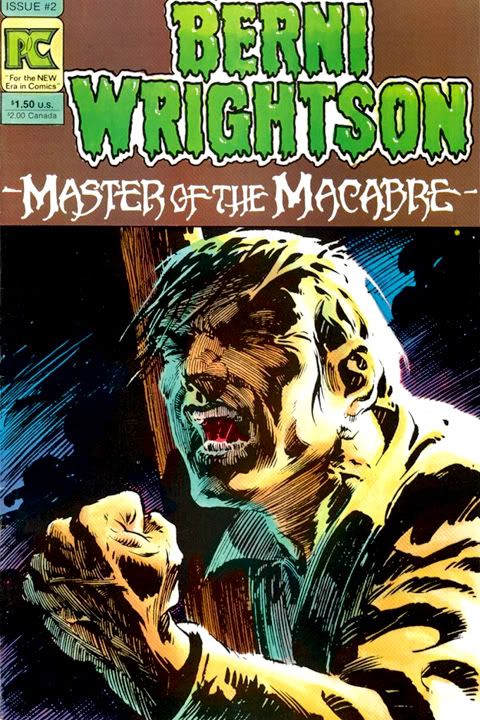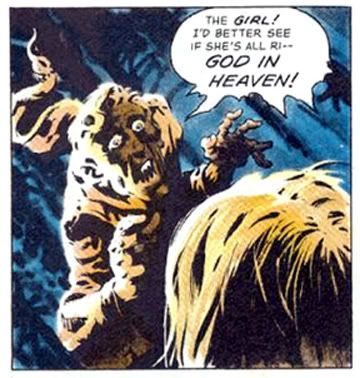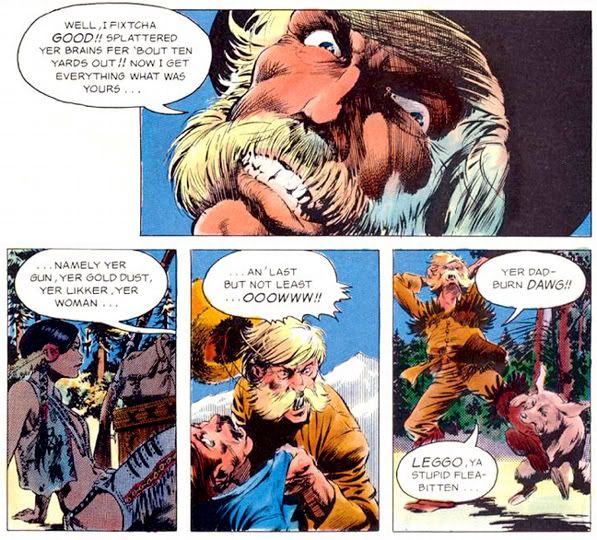 There are just some things that stick in your mind. Just to give you one example from Berni Wrightson-- Master of the Macabre, axes. Axes certainly stick in the mind. But also comic book stories. One sunny day circa 1984 (might've been 1985), my dad drove two of my friends and me to a coin shop that was going out of business and we found a couple of longboxes of recent comics going cheap.
There are just some things that stick in your mind. Just to give you one example from Berni Wrightson-- Master of the Macabre, axes. Axes certainly stick in the mind. But also comic book stories. One sunny day circa 1984 (might've been 1985), my dad drove two of my friends and me to a coin shop that was going out of business and we found a couple of longboxes of recent comics going cheap.Which was good because some of them had the unheard-of cover price of $1.50! Insane! The Uncanny X-Men, the best comic book in the world at the time (according to everyone around me) retailed for less than half that. But I was a lover of fine sequential art and knew of this Berni Wrightson guy from the rad and gory Creepshow adaptation I read at Waldenbooks a million times but was too chickenshit to buy because each peep gave me nightmares, so I bought issues two and three of Berni Wrightson-- Master of the Macabre and gladly paid...
Well, thinking back, I believe we got a ton of fairly new comics for a quarter each! Some poor numismatist's loss was my gain. My dad dropped us off at my friend's house and we went to his bedroom to read our new comics and I promptly discovered a new source of nightmares-- one of the most disturbing and memorable comic book stories of all time. I'm talking about "Jenifer," a tale of pure nastiness. "Jenifer" bows in issue #2.
Some poor jackass goes on a hunting trip, hears someone sobbing among the trees and bags a would-be murderer instead of a trophy buck. He also gets possession of the homeliest child since the Wayan Bros. sprang Little Man on an unsuspecting public. The hunter also has the disquieting realization the person crying wasn't the poor, dishevelled girl but rather the man who was attempting to kill her.
 I'm going to spare you the sight of Jenifer's face. But I will tell you she proceeds to insinuate herself into the hunter's life by driving away his squeamish family and then by occupying his wife's former place in the bedroom. And when hobos and neighborhood children disappear and the hunter can no longer live with his icky obsession, he discovers Jenifer's true power. Despite my having read it in a brightly lit suburban bedroom on a perfectly sunny afternoon, "Jenifer" creeped me out more than a midnight visit to a moonlit cemetery or a dilapidated, moss-covered manse inhabited by neo-gothic weirdos ever could. For two or three nights afterwards, I couldn't sleep for fear Jenifer would appear at my bedroom door and I'd be unable to resist her mute entreaties...
I'm going to spare you the sight of Jenifer's face. But I will tell you she proceeds to insinuate herself into the hunter's life by driving away his squeamish family and then by occupying his wife's former place in the bedroom. And when hobos and neighborhood children disappear and the hunter can no longer live with his icky obsession, he discovers Jenifer's true power. Despite my having read it in a brightly lit suburban bedroom on a perfectly sunny afternoon, "Jenifer" creeped me out more than a midnight visit to a moonlit cemetery or a dilapidated, moss-covered manse inhabited by neo-gothic weirdos ever could. For two or three nights afterwards, I couldn't sleep for fear Jenifer would appear at my bedroom door and I'd be unable to resist her mute entreaties...
One thing I've noticed about Berni Wrightson. Or is it Bernie these days? Whatever-- the guy draws autumn forest scenes like nobody's business. You can almost hear the wind rustling through the trees and the dry leaves crunching underfoot. With a few slashes of black ink across a figure's body to indicate the shadows cast by tree limbs and lots of he manages to capture the slanting sunlight and parched, cool air and give it a disquieting effect. I guess it also has to do with the unexpected encountering of a horrific tableau in an otherwise serene setting. I know Wrightson has done this kind of thing a number of times, so I have to declare him not only the master of the macabre but also of making a daylight forest scene as frightening as any set at night.
Issue #3 leads off with "King of the Mountain, Man," a shaggy-dog story about a Lee Marvin-esque frontier type who literally knocks the brains out of his more genteel business partner with a long rifle then takes all his possessions. He gets a dog he immediately stomps into bloody goo, a rifle that explodes in his hands, liquor that's gone bad and a whole lot of worthless iron pyrite. Which leaves only the woman, a nubile Native American gal wearing almost nothing.
In the story's final panel, we learn she's not exactly right, either. But to be honest, the reprint's coloring obscures her secret so I'm not exactly sure what it is we're supposed to think is wrong with her; I just know Lee Marvin isn't so happy. And yes, the sexual and cultural politics involved in the Native American character-- she's totally objectified, completely mute, evidently owned as property and instantly ready to put out for this foul-tempered, none-to-bright, one-note mountain man despite his having killed her husband or lover before her very eyes-- would make for a fascinating essay by someone much smarter than myself. I don't want either to excuse or defend it, but it's pointless to look for depth or sensitivity in what's essentially a bawdy joke where even the main character remains a broadly-drawn caricature.
Still, considering that "King of the Mountain, Man" was written and drawn in 1971, I'd like to think comic book social conscience had made great strides over the following ten or so years. Unfortunately, Chris Claremont and Sal Buscema put Dani Moonstar in an almost identical Native American sex-girl outfit in The New Mutants #17, which came out roughly around the time I was reading Berni Wrightson-- Master of the Macabre #3. And bear in mind Dani as a character is probably all of sixteen during that storyline. Hell, a quarter century after that and it still seems without erotic fetish imagery repeated to the point of cliche, we'd almost have no female characters in American comics at all.
The other stories in the two comics are just as gorgeously delineated by Wrightson, and there's plenty of blood and guts for the Fangoria crowd, and for the literary-minded, an H.P. Lovecraft adaptation introduced by a decapitated Cousin Eerie (of all people) and a truly... er... creepy parody of Little Nemo in Slumberland. And "Jenifer." Wow. "Jenifer" is one of those amazing, once-in-a-lifetime stories I guarantee remains prominent in the memories of anyone who dared read it.
Pretty cool stuff.

No comments:
Post a Comment